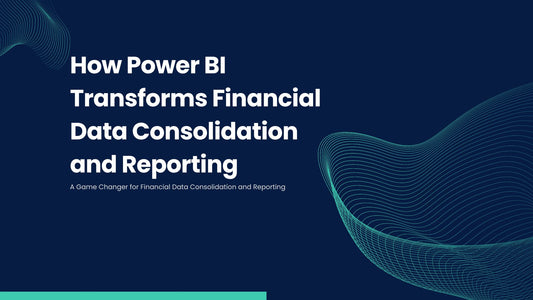Overcoming Consolidation Challenges in Mergers & Acquisitions with Power BI
Mergers and acquisitions (M&A) can bring about significant growth opportunities for businesses, but they also introduce new complexities and risks, particularly when it comes to financial data consolidation. In many instances, the acquiring company may inherit the existing financial systems of the acquired business, either due to cost constraints or the complexities involved in implementing their own systems. This situation can present additional challenges in terms of financial reporting and data integration. In this section, we will explore the risks associated with M&A activities on financial data consolidation and discuss strategies to mitigate these challenges.
M&A-Related Financial Data Consolidation Risks:
When a company acquires another business, it often inherits a variety of financial systems and data sources, each with its unique data formats, definitions, and business rules. This diversity can create several risks for the acquiring organization, including:
Inaccurate Financial Reporting:
The lack of data consistency across the merged entities can result in inaccurate and incomplete financial reporting, potentially impacting decision-making and regulatory compliance.
Increased Complexity:
The process of integrating financial data from the acquired company into the acquiring company's existing systems can be highly complex and time-consuming, leading to delays in obtaining consolidated financial information.
Data Silos:
The disparate financial systems of the merged entities can lead to data silos, where information remains isolated and inaccessible to other parts of the organization. This fragmentation can hinder the company's ability to gain a comprehensive view of its financial health.
Compliance Challenges:
Ensuring that the acquired company's financial data adheres to the acquiring company's regulatory requirements and internal controls can be a complex and resource-intensive process.
Strategies for Addressing M&A-Related Financial Data Consolidation Challenges:
To mitigate the risks associated with M&A activities on financial data consolidation, organizations should consider adopting the following strategies:
Conduct Thorough Due Diligence:
Prior to any M&A activity, the acquiring company should conduct a thorough due diligence process to assess the acquired company's financial systems, data sources, and data quality. This assessment can help identify potential data inconsistencies and integration challenges, enabling the acquiring company to develop a proactive plan for addressing these issues.
Develop a Comprehensive Data Integration Plan:
The acquiring company should create a detailed data integration plan, outlining the steps required to consolidate and integrate the acquired company's financial data into its existing systems. This plan should include a clear timeline, resource requirements, and contingency measures to address any unforeseen challenges.
Implement Data Governance and Compliance Frameworks:
The acquiring company should establish a robust data governance and compliance framework to ensure data consistency and accuracy across the merged entities. This framework should include data definitions, standards, and processes, as well as compliance measures aligned with the relevant industry standards and regulatory requirements.
Leverage Technology Solutions:
Organizations should invest in advanced ETL tools, data integration platforms, and automation technologies to streamline the process of consolidating financial data from the acquired company. These tools can help reduce manual efforts, improve data accuracy, and minimize the time required to obtain consolidated financial information.
Mergers and acquisitions can pose significant challenges to financial data consolidation, particularly when the acquiring company inherits the existing financial systems of the acquired business. By understanding these risks and adopting a proactive approach to addressing them, organizations can effectively navigate the complexities of M&A-related financial data consolidation and ensure the accuracy and integrity of their financial information. In doing so, businesses can successfully capitalize on the growth opportunities presented by mergers and acquisitions while maintaining robust financial reporting and decision-making capabilities.
Can Power BI make a difference?
To further enhance the strategies for addressing M&A-related financial data consolidation challenges, organizations can leverage business intelligence (BI) tools, such as Power BI, to mitigate risks and streamline the data integration process. Power BI can assist businesses in the following ways:
Data Visualization and Exploration:
Power BI provides an intuitive platform for visualizing and exploring financial data from multiple sources, enabling organizations to quickly identify discrepancies, inconsistencies, and trends. By using Power BI to analyze consolidated financial data, senior executives and CEOs can gain valuable insights into the merged entities' financial performance and make informed decisions.
Data Integration and Transformation:
Power BI offers robust data integration and transformation capabilities, allowing organizations to connect to various financial systems, extract relevant data, and transform it into a consistent and unified format. This feature can significantly simplify the process of consolidating financial data from the acquired company, reducing the time and effort required to obtain accurate financial information.
Customizable Reporting:
Power BI enables organizations to create customized financial reports and dashboards that cater to their unique business needs and regulatory requirements. By leveraging Power BI's customizable reporting capabilities, companies can ensure compliance with industry standards and effectively monitor their financial performance following an M&A activity.
Real-Time Data Access:
Power BI allows users to access real-time financial data, empowering senior executives and CEOs to make timely and informed decisions based on the latest information. This feature can be especially beneficial during the post-acquisition integration phase, as organizations can closely monitor the progress of data consolidation efforts and quickly address any emerging challenges.
Collaboration and Sharing:
Power BI facilitates collaboration and sharing of financial data and insights among team members and stakeholders. By leveraging Power BI's collaboration features, organizations can ensure that all relevant parties have access to the latest financial information, fostering a culture of data-driven decision-making throughout the merged entities.
In conclusion, Power BI can play a pivotal role in mitigating the risks associated with M&A-related financial data consolidation by streamlining the data integration process, providing real-time access to financial information, and enabling organizations to create customized financial reports that adhere to compliance requirements. By leveraging the powerful capabilities of Power BI, businesses can effectively navigate the complexities of financial data consolidation during mergers and acquisitions, ensuring the accuracy and integrity of their financial information for better decision-making and enhanced financial performance.




